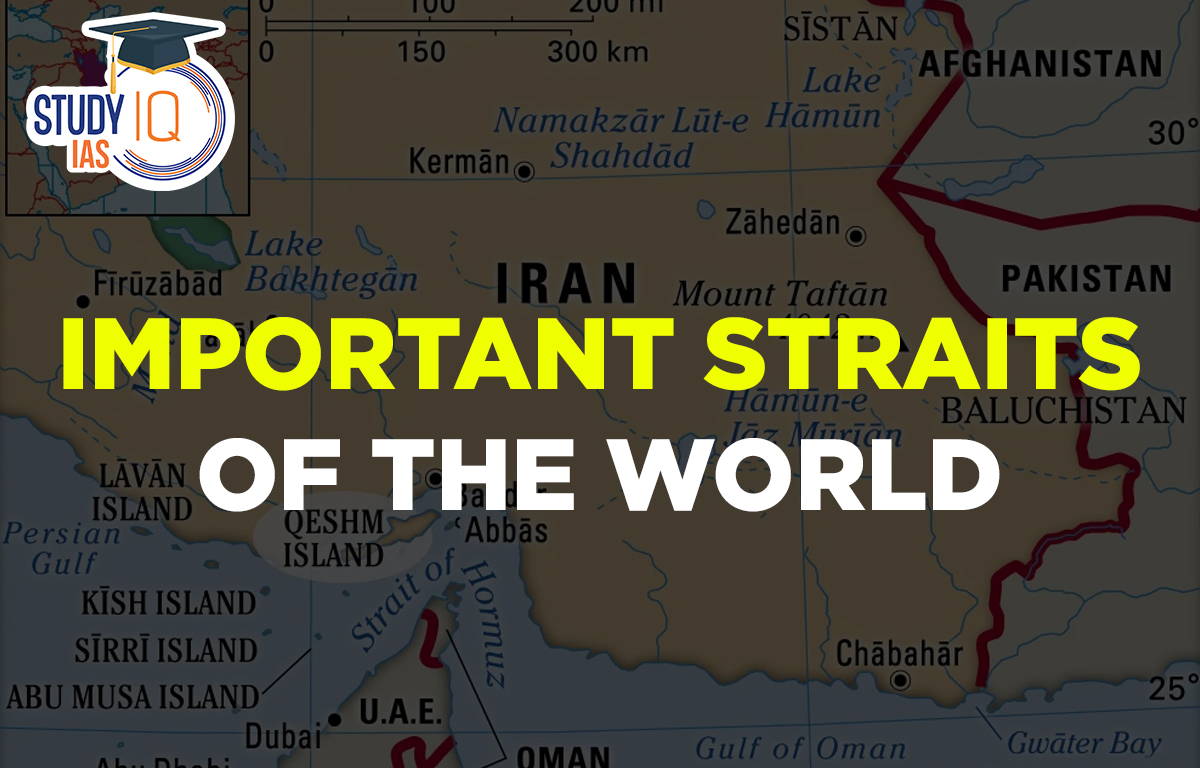Table of Contents
Important Straits of the World
Straits are typically narrow, naturally occurring channels connecting two main bodies of water. They are of vital geographical, economic, and geopolitical significance, being key maritime chokepoints for trade, military transit, and transport of resources. Any disruption to these essential routes can have a bearing on the whole world.
Important Straits of the World: Commercial shipping uses the world’s major straits to cross from one sea or exclusive economic zone to another, and they are of utmost strategic and economic significance. Additionally, they act as a passageway for ocean currents, which alter the local climate. They are significant in both physical and human geography for these reasons.
What is a Strait?
A strait connects two larger bodies of water and is a naturally created, narrow, often navigable waterway. It is most frequently a waterway that separates two geographical masses. Some straits are impassable for a variety of reasons, such as being too shallow, having an impassable reef, or having an impassable archipelago.
List of Major Straits of the World
Here is the list of Important Straits of the World:
| S No. | Major Straits of the world | Connecting |
| 1 | STRAIT OF GIBRALTAR | Atlantic Ocean with the Mediterranean Sea |
| 2 | STRAIT OF HORMUZ | Between Iran to the north and Oman (Musandam exclave) and the United Arab Emirates to the south. |
| 3 | PALK STRAIT | Bay of Bengal with the Gulf of Mannar |
| 4 | MALACCA STRAIT | Peninsular Malaysia is separated from the Indonesian island of Sumatra. It connects the Pacific and Indian oceans. It allows for a shorter route from the Andaman Sea to the South China Sea and is now the world’s busiest waterway. |
| 5 | SUNDA STRAIT | It connects the Java Sea to the Indian Ocean and separates Indonesia’s Java and Sumatra islands. |
| 6 | NINE DEGREE CHANNEL | Connects the Laccadive islands of Kalapeni, Suheli Par & Maliku Atoll. |
| 7 | TEN DEGREE CHANNEL | Divides the Andaman Islands from the Nicobar Islands in the Bay of Bengal. |
| 8 | ORANTO STRAIT | Connects the Adriatic Sea and the Ionian Sea and divides Italy from Albania. |
| 9 | BOSPHORUS STRAIT | Connects the Black sea with the sea of Marmara. The narrowest strait that is navigable. |
| 10 | LA PAROUSES STRAIT | Connects the Sea of Okhotsk with the Sea of Japan. |
| 11 | BERING STRAIT | It separates Russia and Alaska and connects the Arctic Ocean’s East Siberian Sea to the Pacific Ocean’s Bering Sea. |
| 12 | TAIWAN STRAIT OR FORMOSA STRAIT | It is located between Taiwan and Mainland China. It links the South China Sea with the East China Sea. |
| 13 | STRAIT OF TARTARY/TARTAR | It is a strait in the Pacific Ocean that separates the Russian island of Sakhalin from the Asian mainland (specifically, the Khabarovsk Krai and Primorsky Krai regions of Russia). |
| 14 | MOZAMBIQUE STRAIT | It is located in the Indian Ocean between Mozambique from Madagascar. |
| 15 | DAVIS STRAIT | It links Baffin Bay with the Atlantic Ocean. |
| 16 | FLORIDA STRAIT | Located between Florida State and the USA and Cuba. |
| 17 | COOK STRAIT | It connects the Tasman Sea to the South Pacific Ocean and is located between New Zealand’s north and south islands. |
| 18 | TORRES STRAIT | It is situated in the Pacific Ocean, between Australia’s Cape York Peninsula and Papua New Guinea. |
| 19 | DOVER STRAIT | It is located in the English Channel’s narrowest section, connecting to the North Sea. It separates the United Kingdom from the rest of Europe. |
| 20 | NORTH CHANNEL | It separates Ireland and Scotland and connects the Irish Sea to the Atlantic Ocean. |
| 21 | HUDSON STRAIT | It links Hudson Bay [Canada] with the Labrador Sea. |
| 22 | YUCATAN STRAIT | It connects the Gulf of Mexico to the Caribbean Sea and is located between Mexico and Cuba. |
| 23 | MAGELLAN STRAIT | It divides Mainland South America from Tierra Del Fuego |
| 24 | BASS STRAIT | It divides Tasmania from the Australian mainland |
| 25 | DUNCAN PASSAGE | North and Little Andaman to the South |
| 26 | TORRES STRAIT | located in the Pacific Ocean, between the Cape York Peninsula of Australia and Papua New Guinea. |
How is a Strait Formed?
Straits might form as a result of the isthmus’s fracture, which has a narrow shape. It links various bodies of water. Straits are said to be the outcome of plate tectonic action. For instance, the Strait of Gibraltar was formed as a result of tectonic activity in Africa.
A breakdown of the Gibraltar Isthmus is presented. However, human action also produces straits known as canals, which are called. It is employed to control water flow for home and industrial applications. Built in 1869, the Suez Canal is one such strait. It acts as a watershed between the Mediterranean and the Red Sea. It was initially built as a commercial route, and today it connects Europe and Asia via water. Without a watershed, it would take longer to transport products because one would have to go into Africa. As a result, certain straits are designed to promote commerce.
Additionally, as water bodies flood, straits can form. Straits are also created by landslides and erosion. The Black Sea and the Aegean Sea are connected by the Bosporus. The Bosporus was formed as a result of natural weathering and erosion. The Bosporus is essential for geologists because it is the only physical barrier separating the continents of Europe and Asia.
Significance of Straits of the World
- It is crucial to geopolitics since it creates the ocean’s passage. Additionally, it is crucial regarding economic and military problems.
- In the seaborne trade for commercial shipping, straits are crucial.
- For thousands of years, the Straits have been vital to human civilisation.
- They are significant in both military and economic affairs.
- Commercial shipping uses the world’s major straits to cross from one exclusive economic zone or sea to another.
- Straits are crucial both strategically and commercially. For many ships, straits offer a variety of passable paths. For instance, the Strait of Hormuz is crucial since it is where one-third of the world’s oil commerce passes.
- With the aid of turbines, straits are also used to harness tidal energy. For instance, Cook’s Strait of New Zealand generates 5.6 GW of energy.
- The Strait is crucial in that it acts as a conduit for ocean currents, which helps to shape the climate of that region. Because of this, straits are important to both physical geography and human geography.
- Additionally useful for travel to and from the economic zones are the straits. They are also crucial for navigation since they give the many ships that pass by a way to travel.
| Related Articles | |
| Indian Ocean | Pacific Ocean |
| Coral Reef | Indian Ocean Dipole |


 Daily Quiz 05 July 2025
Daily Quiz 05 July 2025
 SSC MTS Apply Online for 1075 Posts – ...
SSC MTS Apply Online for 1075 Posts – ...
 Dynamic Pricing: What It Is and Why It's...
Dynamic Pricing: What It Is and Why It's...





















